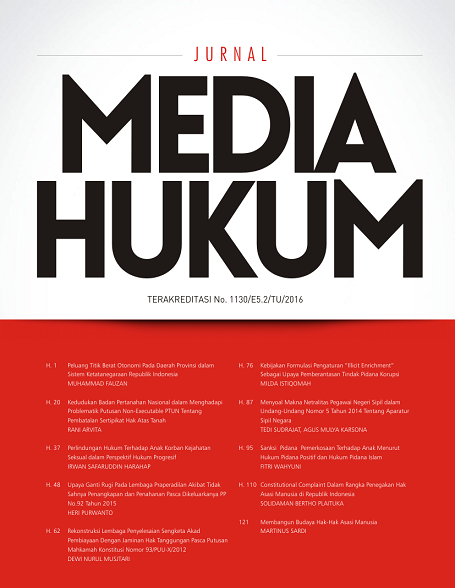Green Victimology Perspective the Law Number 32 of 2009 on Environmental Protection and Management
DOI:
https://doi.org/10.18196/jmh.20200153Keywords:
green victimology, ecocentrism, anthropocentrism, environmental harmAbstract
Green victimology refers to the study of victimology that focuses on victims of environmental harm. The object of this new study cannot be separated from the philosophical values that underlie the growth of green victimology. Through literature research based on secondary data, this research focuses on two studies. The first is about the philosophical foundations of green victimology and the second is about the perspective of green victimology in the Law Number 32 og 2009 on Environmental Protection and Management. Based on the results of the research, it can be stated that the foundation of green victimology ecocentrism which sees that the environmental entities have intrinsic value in virtue of their own interests apart from its instrumental or utilitarian value for humans. This is different from the values underlying the previous victimological study that was based on anthropocentrism. Ecocentrism has been adopted in the Law Number 32 of 2009 on Environmental Protection and Management.References
Book
Angkasa, (2020). Viktimologi, Depok, RajaGrafindo Persada,
Eckersley, (1992). Environmentalism and Political Theory: Toward an Ecocentric Approach. New York: State University of New York Press.
Fisher (2010). Jurisprudential challenges to the protection of the natural environment. In: Maloney M and Burdon P (eds) Wild Law - in Practice. London: Routledge ,.
Garstecki, (2006). Implementation of Article 16, Council Regulation (EC) No. 338/97, in the 25 member states of the European Union. A TRAFFIC Europe Report for the European Commission, Brussels, Belgium. Cambridge: TRAFFIC Europe
Hall. (2009). Victims of crime: Policy and practice in criminal justice. Cullompton: Willan Publishing.
Hall. (2013). Victims of Environmental Harm: Rights, Recognition and Redress Under National and International Law. London: Routledge.
Hiskes (2008). The Human Right to a Green Future: Environmental Rights and Intergenerational Justice. Cambridge: Cambridge University Press.
Schnaiberg. (1980). The Environment: From Surplus to Scarcity. New York: Oxford University Press.
Separovic, Zvoimir Paul. (1974). Victimologi a New Approach in the Social Science. Victimology a New Focus.
Skinnider. (2011). Victims of Environmental Crime - Mapping the Issues. Vancouver: The International Center for Criminal Law Reform and Criminal Justice Policy.
Wyatt T. (2013). Wildlife Trafficking: A Deconstruction of the Crime, the Victims, and the Offenders. Basingstoke: Palgrave Macmillan.
Journal:
C, Stone. (1972). Should trees have standing? Toward legal rights for natural objects. Southern California Law Review Vol. 45.
Christopher William. (1996), An environmental victimology. Social Science 23 (1): 16-40. Reprinted in: White R (2009) Environmental Crime: A Reader. Cullompton: Willan Publishing.
Christopher Williams. (2013). Wild law in Australia: Practice and possibilities. Environmental Planning and Law Journal 30.
De Lucia. (2015), Competing narratives and complex genealogies: The ecosystem approach in international environmental law. Journal of Environmental Law 27 (1).
Donnelly B and Bishop P. (2007), Natural law and ecocentrism. Journal of Environmental Law 19 (1): 89.
Flyn, M & Hall, M. (2017). The case for a victimology of nonhuman animal harms. Contemporary Justice review, doi:https://doi.org/10.1080/10282580.2017.1348898
Hall, M. (2014). Environmental harm and environmental victims scoping out a 'green victimology'. International Review of Victimology, 20 (1), 129-143.
Herbig J and Joubert S. (2006). Criminological semantics: Conservation criminology - vision or vagary ?. Acta Criminologica 19 (3).
Lin A. (2006). The unifying role of harm in environmental law. Wisconsin Law Review 3.
M. J, Lynch. Mc.Gurrin, D. & Fenwick, M. (2004). Disappearing act: The representation of corporate crime research in criminological literature. Journal of Criminal Justice, Vol. 32 (5).
Matthew, p. (2013). Environmental harm and environmental victims: Scoping out a 'green victimology' International Review of Victimology. Vol 20 (1) 129–143 ªThe Author (s) 2013 Reprints and permission: sagepub.co.uk/journalsPermissions.nav doi: 10.1177 / 0269758013508682.
Melanie Flyn and Matthew Hall, (2017). The case for a victimology of nonhuman animal harms. Contemporary Justice review, 2017https://doi.org/10.1080/10282580.2017.1348898
Nurse, A. (2012). Repainting the thin green line: The enforcement of UK wildlife law. Internet Journal of Criminology. Retrieved March 30, 2014, from https://www.internetjournalofcriminology.com/ Nurse_Repainting_The_Thin_Green_Line_IJC_Oct_2012.pdf.
Olszynski, Martin. (2005) The Assessment of Environmental Damages Following the Supreme Court's Decision in Canfor. Journal of Environmental Law and Practice, 15-3.
Preston, (2011), The use of restorative justice for environmental crime. Criminal Law Journal 35.
Preston, (2011), The use of restorative justice for environmental crime. Criminal Law Journal 35.
Schlosberg. (2007). Defining Environmental Justice: Theories, Movements, and Nature. Oxford University Press.
Taylor, R., (2001). A step at a time: New Zealand's progress toward hominid rights Animal Law Review, 7.
Voiceless. (2009). The animal law toolkit. Available at:www.voiceless.org.au .
Walter. (2006). Crime, bio-agriculture and the exploitation of hunger. British Journal of Criminology 46 (1).
Walters B. (2011). Enlarging our vision of rights: The most significant human rights event in recent times? Alternative Law Journal 36 (4).
Wellsmith, M. (2011). Wildlife crime: The problems of enforcement. European Journal on Criminal Policy and Research, 17, 125–148.
White R. (2016). Inter-species violence: Humans and the harming of animals. In: Stubbs J and Tomsen S (eds) Australian Violence: Crime, Criminal Justice and Beyond. Sydney: The Federation Press.
White, Rob. (2013). Environmental Harm: An Eco-Justice Perspective. Bristol Policy Journal.
White, Rob. (2015). Environmental victimology and ecological justice. In: Wilson D and Ross S (eds) Crime, Victims and Policy: International Contexts, Local Experiences. Basingstoke: Palgrave Macmillan.
White, Rob. (2018). International Review of Victimology. Reprints and permission: sagepub.co.uk/journalsPermissions.nav doi: 10.1177 / 0269758017745615
William C. (1996). An environmental victimology. Social Science 23 (1): 16-40. Reprinted in: White R (2009) Environmental Crime: A Reader. Cullompton: Willan Publishing.










